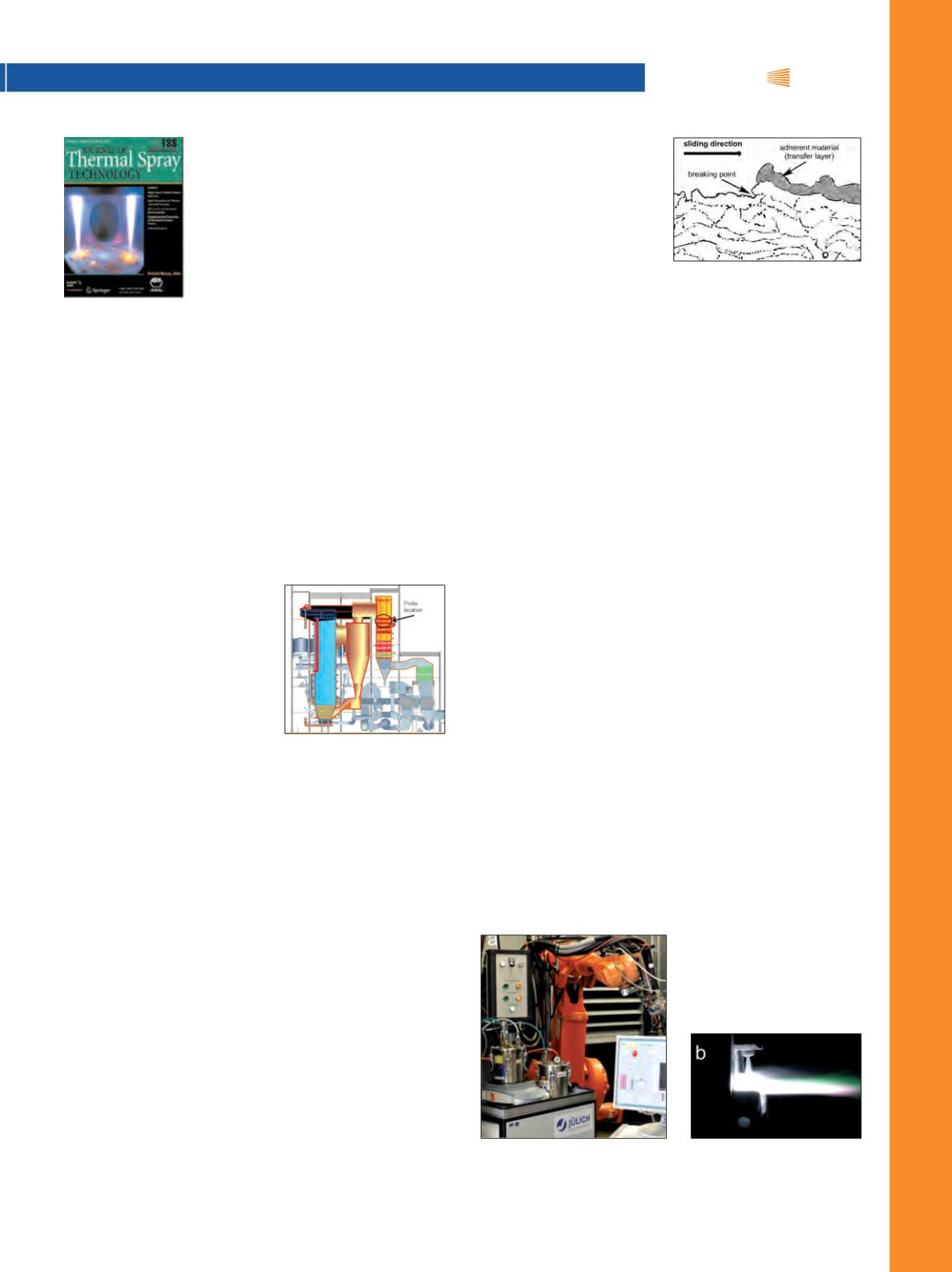

JTST
HIGHLIGHTS
The Journal of Thermal Spray Technolo-
gy (JTST)
, the official journal of the ASM
Thermal Spray Society, publishes con-
tributions on all aspects—fundamental
and practical—of thermal spray science,
including processes, feedstock manu-
facture, testing, and characterization.
As the primary vehicle for thermal spray
information transfer, its mission is to syn-
ergize the rapidly advancing thermal spray industry and relat-
ed industries by presenting research and development efforts
leading to advancements in implementable engineering appli-
cations of the technology. Articles from the January issue, as
selected by
JTST
Editor-in-Chief ChristianMoreau and Lead Ed-
itor Armelle Vardelle, are highlighted here. This issue features
papers based on presentations at ITSC 2014. In addition to the
print publication,
JTST
is available online through springerlink.
com. For more information, visit
asminternational.org/tss.“Thermal Spray Coatings for High-Temperature Corrosion
Protection in Biomass Co-Fired Boilers”
M. Oksa, J. Metsäjoki, and J. Kärki
There are over 1000 biomass
boilers and roughly 500 plants us-
ing waste as fuel in Europe, and
numbers are increasing. Many
encounter serious problems with
high-temperature corrosion due
to detrimental elements such as
chlorides, alkali metals, and heavy
metals. HVOF spray produces very
dense and well-adhered coatings,
which can be applied for corro-
sion protection of heat exchanger
surfaces in biomass and waste-to-energy power plant boilers.
Four HVOF coatings and one arc sprayed coatingwere exposed
to actual biomass co-fired boiler conditions in a superheater
area with a probe measurement installation for 5900 h at 550°
and 750°C. Coatingmaterials includeNi-Cr, IN625, Fe-Cr-W-Nb-
Mo, and Ni-Cr-Ti. CJS and DJ Hybrid spray guns were used for
HVOF spray to compare the corrosion resistance of Ni-Cr coat-
ing structures. Reference materials were ferritic steel T92 and
nickel super alloy A263. The circulating fluidized bed boiler
burnt a mixture of wood, peat, and coal. Coatings show excel-
lent corrosion resistance at 550°C compared to ferritic steel.
At higher temperature, NiCr sprayed with CJS had the best
corrosion resistance. IN625 was consumed almost completely
during exposure at 750°C.
“In Situ Wear Test on Thermal Spray Coatings in a Large
Chamber Scanning Electron Microscope”
Weifeng Luo, Wolfgang Tillmann, and Ursula Selvadurai
Currently, mass loss determination is usually used for
quantitative evaluation of
wear tests, while analysis of
wear tracks is used for qual-
itative evaluation. Both eval-
uation methods can only be
used after wear testing and
results can only be present-
ed in the final outcome of
wear tests. However, chang-
es during the wear test and
time-dependent wear mechanisms are also of great interest.
A running wear test in a large chamber scanning electron
microscope (SEM) offers the first opportunity to observe the
wear process in situ. Different wear mechanisms, such as the
adhesive, abrasive wear, surface fatigue, and tribochemical
reaction, can be recorded with high magnification. A special
pin-on-disk testing device was designed for a vacuum envi-
ronment. Using this device, arc-sprayed NiCrBSi coatings and
HVOF-sprayed WC-12Co coatings were tested in a large cham-
ber SEMwith Al2O3 ceramic balls as wear counterparts. During
wear testing, different wear mechanisms were determined
and processes were recorded in short video streams.
“Columnar-Structured Mg-Al-Spinel Thermal Barrier
Coatings (TBCs) by Suspension Plasma Spraying (SPS)”
N. Schlegel, S. Ebert, G. Mauer, and R. Vaßen
Suspension plasma spray (SPS) was developed to per-
mit feeding of sub-micrometer-sized powder into the plasma
plume. In contrast to electron beam-physical vapor deposi-
tion and plasma spray-physical vapor deposition, SPS enables
cost-efficient deposition of columnar-structured coatings.
Due to their strain tolerance, these coatings play an import-
ant role in the field of thermal barrier coatings (TBCs). Yttria
partially stabilized zirconia (YSZ) is commonly used as TBC
material. However, its long-term application at temperatures
higher than 1200°C is problematic. At these high temperatures,
phase transitions and sintering effects lead to the degradation
of the TBC system. To overcome those deficits, Mg-Al-spi-
nel was used as a TBC material. Even though it has a lower
melting point (~2135°C)
and higher thermal con-
ductivity (~2.5 W/m/K)
than YSZ, Mg-Al-spinel
provides phase stability at
Schematic representation of
the surface fatigue around a
pit on a coating’s surface.
Suspension-feeder developed at Forschungszentrum Jülich
GmbH (Germany), showing the monitoring and control unit
(a), and injection of suspension into the plasma jet with a two-
phase atomizer (b).
550 MWth circulating
fluidized bed boiler test
facility with the probe
measurement location.
A D V A N C E D
M A T E R I A L S
&
P R O C E S S E S | F E B R U A R Y 2 0 1 5 |
i T S S e
1 5
iTSSe
|
TSS


















